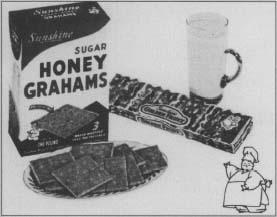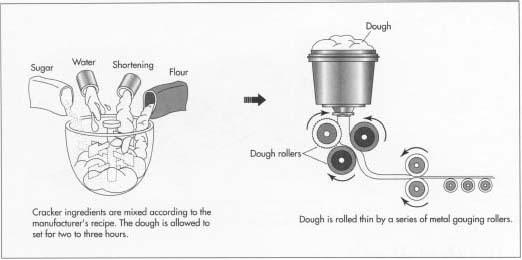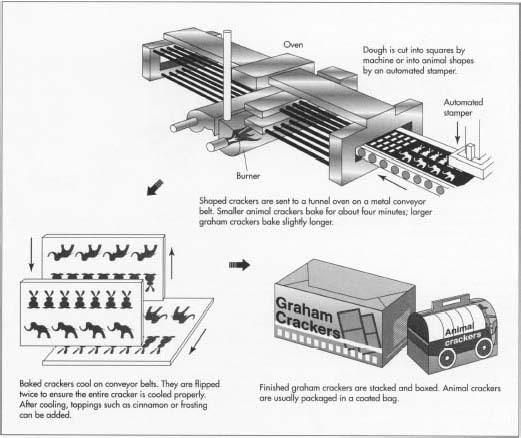Graham Cracker
Background
Graham crackers and related animal crackers are whole wheat crackers made with a special type of flour. They are slightly sweetened with sugar and honey and are sold in a variety of sizes and shapes. First developed in 1829, they remain a popular snack food, and millions of crackers are sold each year.
The development of the graham cracker is attributed to Sylvester Graham, an American clergyman. In 1829, he concocted the recipe for a cracker whose main ingredient was an unsifted, coarsely ground whole wheat flour. Touting his product as a health food, he produced and sold it locally. Over time, it became known the graham cracker. Due to its popularity and innovation, other bakeries copied his recipe and eventually developed methods for its mass production. Since then, graham crackers have been a popular snack food. They have also become an important ingredient in pie crust recipes.
From a recipe standpoint, animal crackers are very much like graham crackers. The primary difference between the two is the shape of the final product. Whereas graham crackers are typically square, animal crackers come in the shape of lions, tigers, camels, bears, and giraffes, to name a few. They were developed in England in the late 1800s and were initially imported to the United States. As their popularity grew, American bakeries began making them. A true innovation in the development of this product came from the National Biscuit Company, who packaged the crackers in a colorful box made to look like a circus wagon. This method of selling the product proved popular and spawned hundreds of variations on this theme. In the late 1950s, production technology improved, and the level of detail on animal crackers greatly increased.
Raw Materials
The recipe for graham crackers has remained essentially unchanged since its invention in 1829. The primary ingredients include whole-wheat flour, fat, and sugar. These, combined with other ingredients, provide the essential graham cracker characteristics.
Flour
The main component of most cracker recipes is wheat flour, which is obtained by grinding wheat seeds into a powder. Whole-wheat flour is composed of the three main parts of the wheat seed, the outer coat or bran, the germ, and the endosperm. The bran and germ are larger particles which add flavor, fiber, and color to the flour. The endosperm is responsible for the important baking characteristics. It is primarily composed of starch and protein, which when combined with water creates a mass, called gluten, that can be stretched and rolled without breaking. This property allows dough to be formed into various sizes and shapes.
The distinctive flavor and texture of graham cracker flour comes from the size of the flour particles used. For the correct taste, the flour must have the correct combination of small, medium, and large particles. If this combination is not right, the crackers will either turn out crumbly or have lumps.
Fats and oils
Fats and oils are another primary ingredient used in cracker manufacturing. They can be derived from a variety of plant and animal sources. Graham cracker recipes typically require hydrogenated vegetable shortening composed of soybean and cottonseed oil. Most of the naturally strong flavor of these oils is removed during the refining process. Butter can also be used. However, its flavor is retained during manufacturing.
There are many characteristics which make fats and oils important in graham cracker recipes. One characteristic is their insolubility in water. When water is added to flour, gluten is typically formed. But when fats and oils are present, they act as a barrier between the flour and water, and gluten formation is prevented. This "shortened" batter results in products that have a soft, crumbly texture. Using fats and oils improve the appearance of crackers and contribute to the taste.
Sweeteners
Graham crackers have a slightly sweet flavor. The primary sweetener is sugar, or sucrose, that is derived from sugar cane or sugar beet. It typically makes up about 5-15% of the recipe. Other sweetening ingredients used are dextrose, corn syrup, molasses, and honey. In addition to adding flavor, these ingredients have the extra benefits of improving the texture, affecting the color, contributing to the aroma, and preserving the product.
Other ingredients
Beyond the primary cracker ingredients, many other materials are added to give graham crackers their unique taste and texture. Cinnamon and salt contribute to the taste of the crackers. Whey is often added to ameliorate flavors without adding much flavor of its own. Leavening ingredients like sodium bicarbonate or sodium acid pyrophosphate give off carbon dioxide when mixed in the dough and are responsible for the air pockets throughout the cracker. Lecithin, which is derived from soybean oil, is used to make manufacturing easier by reducing the stickiness of the batter.

The graham crackers we enjoy today are a far cry from the whole wheat graham cracker that Sylvester Graham developed over 150 years ago. Graham was an early nineteenth century health reformer who lectured on the evils of meat, alcohol, fat, and processed grains such as refined flour. He urged housewives to bake using whole meal wheat flour (with the bran left in the flour) because whole meal or Graham flour rendered first-rate digestive foods. Thus, Graham's name was given to the biscuits, breads, and crackers made from this Graham flour. The true Graham crackers were baked without fat and refined sugar.
Sylvester Graham, born in Connecticut in 1794, was always sickly, small, and suffered from mental breakdowns. He believed a healthful diet would mend his body and mind. By the late 1820s, Graham had turned from foods he considered unhealthy, preferring unprocessed foods, vegetables, and water to refined grains, meat, and alcohol. Graham publicly denounced commercial bakeries, proclaiming their products tainted. Instead, he suggested mothers return to the kitchen and bake bread from whole meal wheat flour rather than purchase inferior products made from refined white flour. Mid-nineteenth century recipe books instructed housewives in testing for fresh Graham flour and featured baked goods of Graham flour—griddle cakes, Graham biscuits, and crackers. The graham cracker was only one such recipe, which later was mass produced and sold by large bakeries, the kind of bakery Graham would have denounced.
Graham crackers now contain whole wheat flour and other ingredients such as sugar and shortening.
Nancy EV Bryk
The Manufacturing
Process
Graham crackers are made through a series of steps which convert the raw ingredients

Ingredient handling
- 1 Most of the major ingredients like flour, vegetable shortening, and sugar are delivered to cracker manufacturers in large quantities and stored in bulk tanks. Depending on the ingredient, these tanks may be fashioned with special equipment to control their internal environments. For example, a liquid such as vegetable shortening must be stored at a specific temperature until it is ready to be used. If the temperature varies too much, the shortening could be difficult to pump or could adversely affect the dough. Therefore, this tank has controls which can maintain the appropriate temperature. Other tanks may have refrigeration capabilities.
- 2 At the start of cracker production, ingredients are transferred to mixing tanks. Liquid bulk ingredients are transferred using metered pumps, which can move a specific quantity of material. Bulk solid materials are pumped via a method called pneumatic transfer, which involves fluidizing the powders with a stream of air and then pumping them with metered pumps. Minor ingredients that are supplied in boxes, bags, and drums are weighed and poured into the mixing tank by hand.
Compounding
- 3 The graham cracker ingredients are mixed together in specific quantities as specified in the recipe. Cracker doughs are mixed with either vertical spindle mixers or high-speed horizontal drum mixers. The order that ingredients are added to the mixture is important. Typically the process begins with sugar, water, and shortening. This forms a mixture with a cream-like consistency. Next the remaining ingredients are added, and a "short" dough is obtained. This dough is allowed to set for two to three hours for the leavening agents to work.
Machining
-
4 Graham crackers are usually sold in two forms, as squares or as animal crackers. The dough used for both is ostensibly the same. In the machining process, the dough is delivered from a hopper onto a conveyor belt and rolled thin by a series of metal gauging rolls. The thickness of the sheet is reduced by each of these rollers. Some manufacturers stack multiple sheets on top of each other in a process known as laminating. They are rolled out further, allowed to relax, and then sent along a conveyor belt to the cutting machines.

- 5 The edges of the dough sheets are cut smooth by rotary cutting machines, and excess dough is sent back to the hopper for reuse. When animal crackers are made, the sheet of dough is cut into the various animal shapes by cutting machines called stampers. These stampers, or rotary dies, have the animal shapes fashioned on them with intricate details. After this stage, sugar, cinnamon, or honey are applied to the top of the dough if the recipe requires it.
Baking
- 6 The crackers are baked in a tunnel oven. The dough is first transferred to a metal conveyor belt and then moved through the oven, which can be 100-300 feet (30-90 m) long. Baking takes place in three stages called development, drying, and coloring. In the development stage the dough sets, taking on the size and shape of the final product. The greatest amount of water is lost in the drying stage. In the coloring stage, the dough is changed from pale white to a light golden brown. The amount of time a product spends baking is controlled by the speed of the moving conveyor belt. Animal crackers bake for as little as four minutes. Graham crackers bake slightly longer.
Post conditioning
- 7 After the crackers come out of the oven, they travel on a series of conveyors to cool. At some point in this process they are flipped over and then flipped back to ensure that cooling is throughout. The total cooling time can be twice as long as the baking time.
- 8 Depending on the recipe, other coatings can be put on the crackers after they have cooled. These include such things as icings, chocolate coatings, or sugar. These can be applied using either stenciling, extruders, or depositors. Excess toppings are removed using forced air and vibrating shaker devices.
Packaging
- 9 The final step in the manufacturing process is packaging. Because of the fragile nature of some crackers, the packaging must be rigid and airtight. For square graham crackers, the crackers are cut and stacked individually and wrapped in flexible films. Animal crackers, which are less fragile, are typically packaged in a coated bag. Both types of crackers are then put inside boxes which are appropriately decorated to make the product appealing. These boxes are put into larger case boxes, which can be stacked on pallets and shipped to stores.
Quality Control
Quality control begins with the evaluation of incoming raw materials. Before they are allowed for use, these ingredients are tested in the Quality Control lab to ensure they conform to product specifications. Various sensory characteristics are checked, including appearance, color, odor, and flavor. Many other characteristics, such as the particle size of solids, viscosity of oils, and pH of liquids, are also studied. Each bakery relies on these tests to certify that the ingredients will produce a consistent, quality batch of graham crackers.
Various characteristics of each batch of final product is also carefully monitored to ensure that every graham cracker or animal cracker shipped to stores is of the same quality as the batches developed in the food laboratory. Quality control chemists and technicians check physical aspects of the crackers, including appearance, flavor, texture, and odor. The usual method of checking these characteristics is by comparing them to an established standard. For example, the color of a random sample is compared to a standard set during product development. Other qualities, such as taste, texture, and odor are evaluated by sensory panels. These are made up of a group of people who are specially trained to notice small differences in these characteristics. In addition to sensory tests, many specialized instrumental tests are also performed.
The Future
The trend in graham cracker products has been toward products which contain premium ingredients, are healthier for the consumer, or have unusual shapes. Graham cracker marketers have tended to tout organic ingredients in the recipes. Others have begun to use a low-fat recipe and make other "healthy" claims. Additionally, new flavors of graham crackers are constantly being introduced in the hopes that they will catch on and sustain sales over many years.
Where to Learn More
Books
Almond, N. Biscuits, Cookies and Crackers: The Biscuit Making Process. Elsevier Applied Science, 1989.
Booth, R. Gordon. Snack Food. Van Nostrand Reinhold, 1990.
Faridi, Hamed. The Science of Cookie and Cracker Production. Chapman & Hall, 1994.
Periodicals
Dornblaser, Lynn. "Everything they're cracked up to be. (new cracker products)" Bakery Production and Marketing, August 15, 1996, p. 26.
— Perry Romanowski